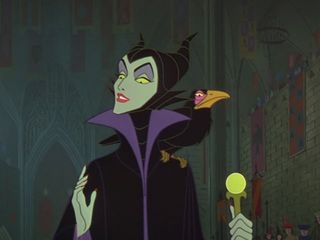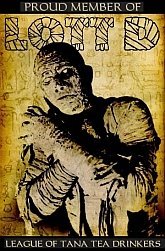
Zombos Says: Very Good
Read Part 5: Frankenstein Meets the Wolf Man
Despite its all star cast, and the return of
Boris Karloff to the fold, the movie was the silliest and dullest of the entire
series. In its non-stop and methodical rushing through stock horror sequences,
it approached the standardization of the "B" Western, and even lacked
the kind of bravura dialogue that at least can provide a pseudo-Gothic veneer. (William
K. Everson, Classics of the Horror Movie)
Although Everson
pans House of Frankenstein, this
second monster rally from Universal's production treadmill is not silly or
dull, and steps lively through its "stock horror sequences" of
brain-swapping mad science, murderous hunchbacked assistants, and star-crossed
lovers, all with a patina of Gothic-noir finesse. It's slick-slacks, neatly
pressed and sharply creased, and while it does not dwell deep in meaning, House
of Frankenstein remains a
well-directed, entertainingly acted, and visually appealing Universal-style
horror movie.
But John
Carradine's portrayal of Dracula is another matter.
Except for his
glowing, mesmerizing, ring providing most of the vampire's menace—it offers a
glimpse of evil shadows moving furtively in a nightmare world—Carradine's Big
Bandleader accoutrement and eye-pop stare brimming from under a silly, tilted
tophat and short opera cape dandily draped across his shoulders, do their best
to murderlize the spookshow tone entirely. At least Dracula's early demise in
the movie lessens our burden of having to suffer Caradine's ham and corn buffet
for long, and frees Larry Talbot (Lon Chaney Jr) to pine away and lament his
lycanthropic curse, which is really the main storyline anyway.
Perhaps Universal
was banking on the audience appeal for the Frankenstein name, but House
of Frankenstein and the subsequent House
of Dracula are two peas in
a pod, and should have been named House of the Wolf Man and Sublet of the Wolf Man respectively.
Maleva the gypsy
is no where to be found; and the Frankenstein brothers, daughters, and
baronesses are gone, too. The Monster (Glenn Strange) remains; more lifeless than ever in body and spirit,
but still recognizable dressed in those defining neck bolts. Erle C. Kenton's patent leather direction, Hans J. Salter's mood-rich music (along
with Paul Dessau), and the creative
best from the art and set decoration B movie crews with what's at hand all
funnel through a lean filming schedule and penny-pinching budget to stir shadow,
menace, and monsters briskly when the lightning strikes again.
Imprisoned mad
Doctor Gustav Niemann (Boris Karloff) escapes the dark, dank prison cell he's
in, along with the homicidal Daniel (J. Carrol Naish), a hunchback outcast
dreaming of a straight and handsome body. Niemann's incessant raving about
brain transplants, swapping human brains with dog brains, and getting even on
those who locked him up appeals to Daniel, who buys into the bad doctor’s
promise to give him a better body.
And isn’t that what the Frankenstein
franchise has always been about? A yearning to be better at science and
medicine; a yearning for a better existence; a yearning for a better companion;
a yearning for a better brain; and a yearning for a better body?
Daniel follows the
Doctor when a lightning bolt blasts open an escape route for them through their
dark prison’s massive stone walls, hoping Niemann will place his brain into that
better body. As the rain pours down, they chance upon Lampini's (George Zucco)
traveling sideshow of horrors. Lampini's reluctance to take them where they
want to go ends abruptly between Daniel's tightly gripping hands, shown through
a flash of sudden terror in Lampini's eyes, Daniel lurching menacingly closer
with those outstretched hands, and a gurgling cry as Niemann smirks in quiet
satisfaction.
With plans for
revenge on those who imprisoned him, and a driving desire to find the life and
death secrets of Frankenstein, Niemann assumes Lampini's name and travels to
Visaria ( or freel free to insert your own village name here since continuity
went out the door with Lampini's body).
Bela Lugosi was originally slated to play
the role of Dracula, but the movie’s shooting schedule was dependent on the
presence of Boris Karloff being released from the stage tour of Arsenic
and Old Lace (1944). Shooting was
delayed, and John Carradine was cast instead of Lugosi, who had a prior
engagement: ironically, playing Karloff's "Jonathan Brewster" role in
another touring company of Arsenic and Old Lace (IMDb entry
on House of Frakenstein).
In the mold of Bride
of Frankenstein's Pretorius, Niemann is a maniacal scientist bent
on one-upping Frankenstein. Brain-swapping becomes modus-operandi, raison d'être, and bargaining
chip for Niemann as he pursues his revenge, first on Burgomeister Hussman (Sig Ruman),
with the help of Count Dracula.
Early drafts of
the story reportedly involved more characters from the Universal Stable,
including the Mummy, The Mad Ghoul, and possibly The Invisible Man (Wikipedia),
but the only monster to remain in Lampini's traveling horror show is Dracula. Curiously,
he is not the vampire late of Whitby Abbey, or even the vampire last seen
burning to ashes in Dracula's Daughter. No
continuity from there to here is intended.
The skeletal
remains of Dracula, with a stake embedded deep into its ribcage, is pure
spookshow dramatics parlayed into a rapidly unfolding and stylish vignette of
terror for Hussman, kicking off Niemann's revenge with a flourish. It begins
with the piecemeal reconstitution of Dracula's body and clothes when Niemann
pulls out the stake in a huff after meeting the Burgomeister. With his threat
of the dreaded stake poised to strike again, and his promise of fealty to the
Lord of the Undead, Niemann convinces Dracula to help him.
In quick
succession, Dracula ingratiates himself to Hussman, seduces and hypnotizes Hussman's
Americanized (meaning perky and hip) granddaughter-in-law Rita (the
effervescent Anne Gwynne), turns into a large bat to kill Hussman (done with a
nifty animated transformation capped by a neck attack shown in silhoette), and
is discovered by Hussman's son Karl (Peter Coe) who realizes what's happening
and sounds the alarm to Inspector Arnz (Lionel Atwill).
With the inspector
and his men in hot pursuit on horseback, Dracula, in turn, chases after Niemann
and Daniel as they race away with his coffin in Lampini's wagon. With the
sunrise moments away, Niemann directs Daniel to dump it. Unable to reach his
daytime santuary in time, Dracula is reduced to a skeleton once again. His
hypnotic influence over Rita ends when his ring falls off his boney finger.
Economically
directed and succinct in execution, it's still exhilarating and entertaining
with flair, and certainly not the script calamity it's purported to be in many
critical analyses. Carradine projects a more energetic Dracula when he's not
staring with widened eyes or donning his tophat, but he doesn't have Lugosi's
seductive and menacing silent presence, or malevolence
when in motion, which, arguably, could be considered a hindrance to the faster
pace of action here.
Continuing to Visaria, they rest at a Gypsy campsite, where
Daniel comes to the aid of a girl being whipped. He insists they shelter her
and Niemann reluctantly agrees. Daniel's infatuation with the playful Ilonka
(Elena Verdugo) is not returned when she sees his hunchback, making him more
impatient to receive the new body promised to him by Niemann.
And the one he wants is already occupied by
Larry Talbot.
Read Part 7: House of Dracula
Photograph of Glenn Strange as the Frankenstein Monster (with Boris Karloff) courtesy of Dr. Macros High Quality Movie Scans.






















